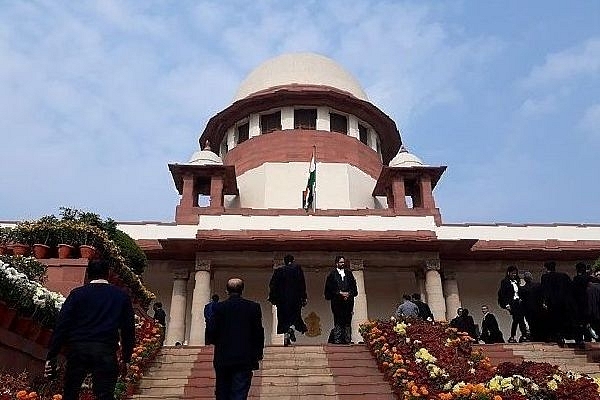
No, Your Lordships, The SC Is As Much Responsible For Weak Judicial Delivery As Anyone Else
It is not the executive’s meddling in the appointment and transfer of judges that is at the root of failing justice administration and delivery, but the court’s own predilections, where laws to speed up justice are simply set aside, and frivolous PILs are allowed to waste judicial time.
The Supreme Court of India is miffed over the long delays in the appointment of judges by the government, with its latest beef being the delay in the elevation of Bombay High Court judge Akil A Kureshi as Chief Justice of the Madhya Pradesh High Court.
A bench hearing a petition filed by the Gujarat High Court Advocates Association against this delay said that (executive) “interference in matters of appointment, transfer and posting of judges go to the root of the system of administration of justice… interference in such matters affects the system of administration of justice and, therefore, does not augur well for the institution.”
The bench was headed by Chief Justice Ranjan Gogoi, with Justice S A Bobde and S Abdul Nazeer being the two judges on it. Justice Kureshi’s case has been championed by the Gujarat High Court Advocates Association since he was earlier with this High Court.
This is a bit rich. One can make a point about executive interference in the judiciary only if the judiciary itself had not arrogated to itself the task of selecting judges on its own – a system that exists nowhere else in the world. But, more importantly, the administration of justice and its delivery does not depend on just how judges are appointed, but how accountable the judiciary is to the needs of justice, and how willing it is to speed up legal processes.
On both counts, the Supreme Court has fallen short. In fact, recent evidence suggests that while the Centre has dragged its feet over one or two recommendations of the collegium, otherwise it has been swift in responding to decisions on appointments and transfer.
In November 2018, Chief Justice Ranjan Gogoi himself expressed astonishment over the speed at which four new judges were appointed at that time. More recently, the Centre has ensured that the Supreme Court functions with its full complement of 34 judges. If anything, it is the collegium’s non-transparent decisions that have come under attack, including the recent decision to transfer Madras High Court Chief Justice Vijaya K Tahilramani to Meghalaya, resulting in her resignation.
The collegium itself is slow because it has to handle the job of judicial selection over and above its already heavy case-load of constitutional and appeal cases pending before it. It would make sense to shift the job of judicial selection to an independent panel, as was proposed by the National Judicial Appointments Commission law. Maybe, the collegium should ask the government to frame a more acceptable law for creating such a panel that it can live with.
But, the second, and more important reason for delays in justice relate to the Supreme Court’s own tendency to thwarting reforms intended to speed up cases. In 1999 and 2002, the Atal Bihari Vajpayee government put through two important amendments to the Code of Civil Procedure to ensure that adjournments are limited to three, and the time taken to issue summons or carrying out “any act prescribed by the code” to a maximum of 30 days (read the details here in this article by Brajesh Ranjan).
But far from delivering justice more quickly, the Supreme Court rejected the iron-clad time limits set and asked courts to read these as mere guidelines. Not surprisingly, no lower court now believes it has to adhere to these guidelines in all cases. Should the apex court give the lower courts such leeway in the time taken to decide cases?
The third reason for delay in the delivery of justice relates to the apex court’s excess use of public interest litigation (PIL). While some PILs – like the one on the 2G scam – have led to landmark verdicts, most others are just publicity-seeking ventures for those who file the petitions.
A count in 2015 found that there were 1,598 PILs pending that year, with some dating back to 1992. With this kind of pending case-load in mostly avoidable PILs, even deciding which PIL is worthy of a hearing can take up many months of judicial time.
PILs are enabled by Article 39, which states that “citizens, men and women equally, have the right to an adequate means to livelihood…”, and further that “the ownership and control of the material resources of the community are so distributed as best to subserve the common good; and “that the operation of the economic system does not result in the concentration of wealth and means of production to the common detriment.”
With such a wide ambit, almost any PIL can get admitted as worthy of consideration by the courts. A law to limit PILs only to situations of manifest unfairness or gross dereliction of duty by the state is sorely needed.
The Supreme Court, given its ability to make the law rather than merely interpreting it, could have done this itself, but has not done so.
So, to put it simply, it is not the executive’s meddling in the appointment and transfer of judges that is at the root of failing justice administration and delivery, but the court’s own predilections, where laws to speed up justice are simply set aside, and frivolous PILs are allowed to waste judicial time.
And yes, the old system of long court vacations cannot have added much to speeding justice delivery.
Not for nothing has senior advocate Harish Salve accused the Supreme Court of being the root cause for the economic slowdown.
The Supreme Court should know that for every finger it points to the executive as the cause for denial of justice, three fingers point towards itself.